Report on Consequences of Abuse in Middle Childhood
VerifiedAdded on 2022/07/27
|8
|2293
|47
AI Summary
Contribute Materials
Your contribution can guide someone’s learning journey. Share your
documents today.
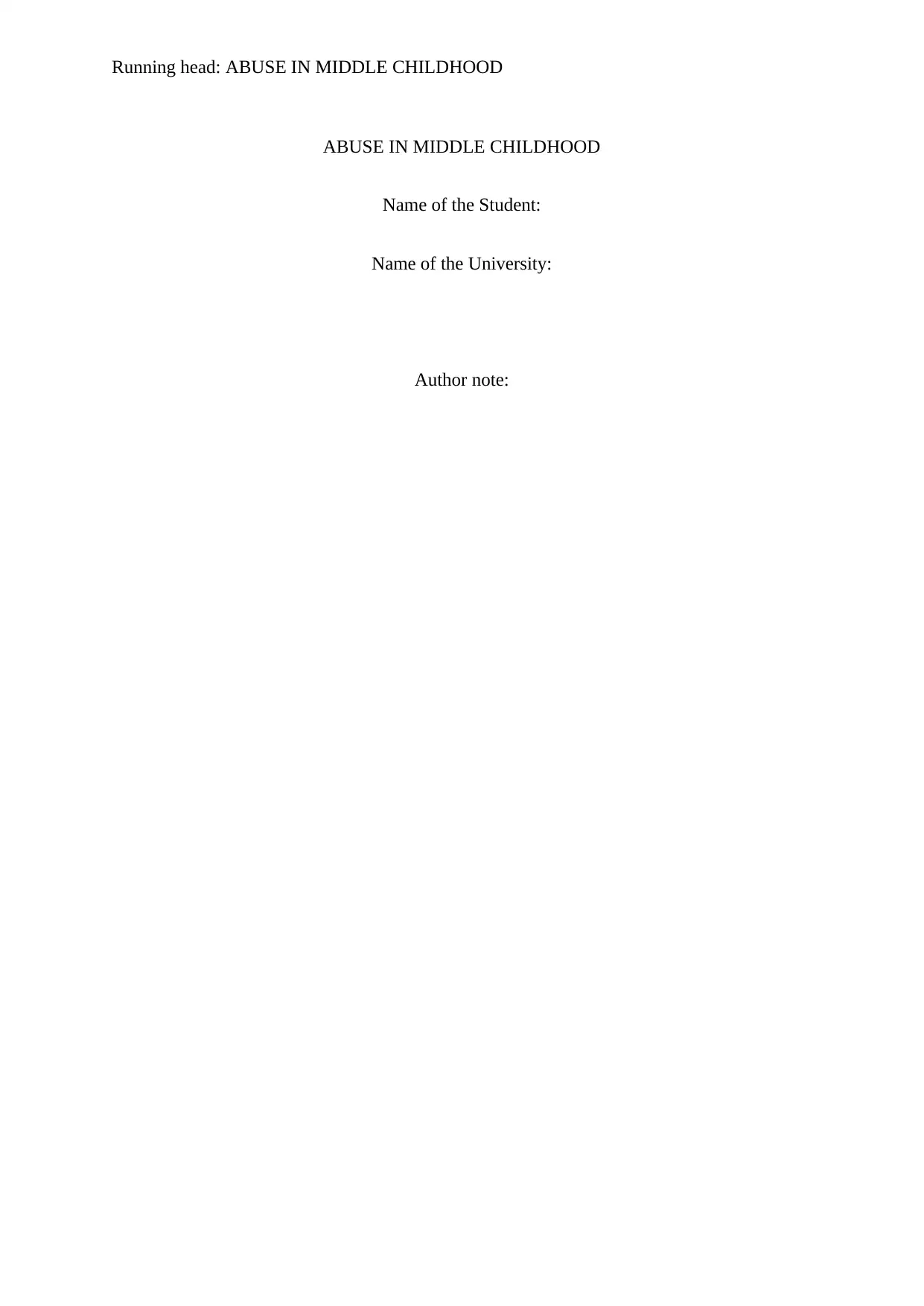
Running head: ABUSE IN MIDDLE CHILDHOOD
ABUSE IN MIDDLE CHILDHOOD
Name of the Student:
Name of the University:
Author note:
ABUSE IN MIDDLE CHILDHOOD
Name of the Student:
Name of the University:
Author note:
Secure Best Marks with AI Grader
Need help grading? Try our AI Grader for instant feedback on your assignments.
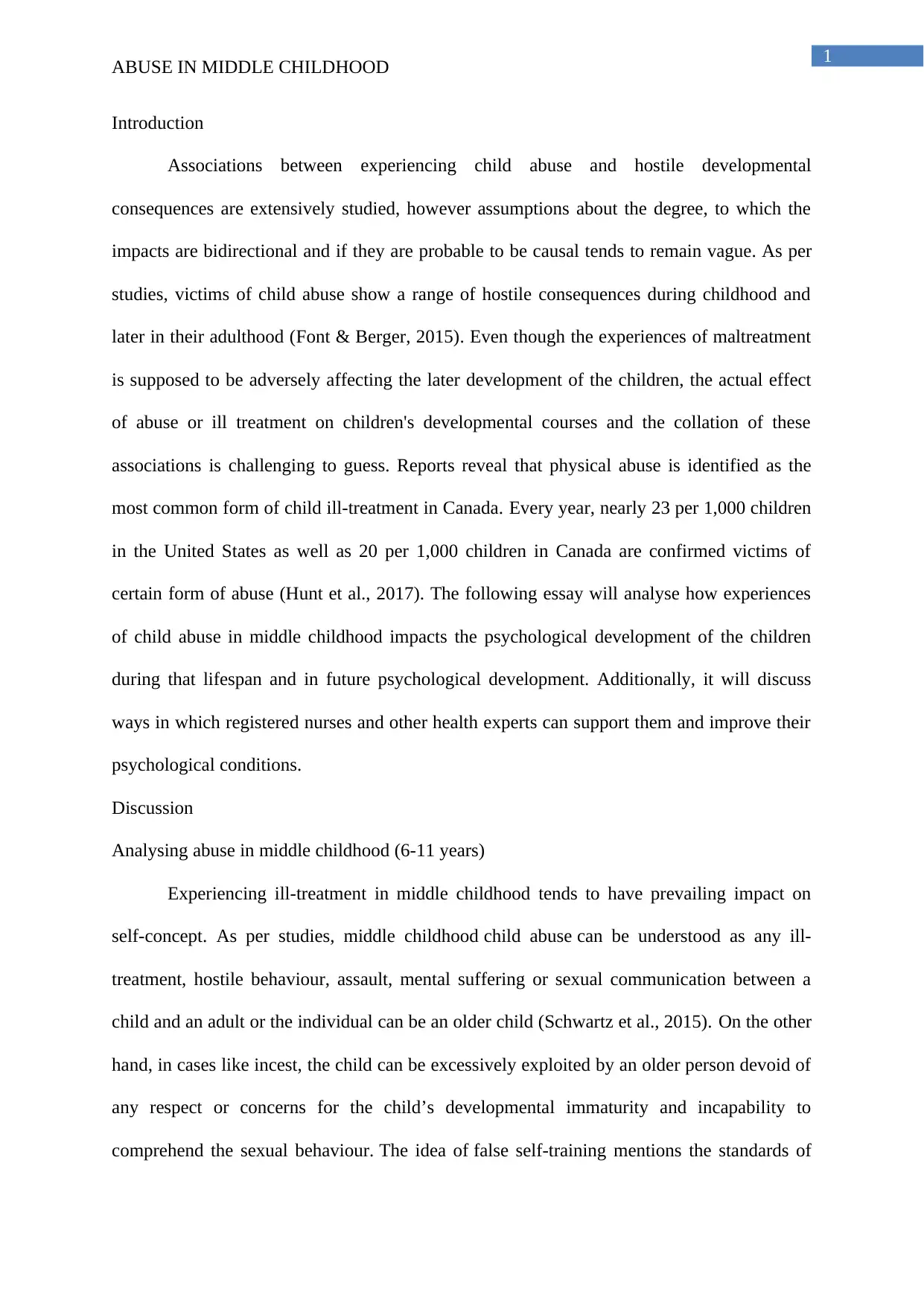
1
ABUSE IN MIDDLE CHILDHOOD
Introduction
Associations between experiencing child abuse and hostile developmental
consequences are extensively studied, however assumptions about the degree, to which the
impacts are bidirectional and if they are probable to be causal tends to remain vague. As per
studies, victims of child abuse show a range of hostile consequences during childhood and
later in their adulthood (Font & Berger, 2015). Even though the experiences of maltreatment
is supposed to be adversely affecting the later development of the children, the actual effect
of abuse or ill treatment on children's developmental courses and the collation of these
associations is challenging to guess. Reports reveal that physical abuse is identified as the
most common form of child ill-treatment in Canada. Every year, nearly 23 per 1,000 children
in the United States as well as 20 per 1,000 children in Canada are confirmed victims of
certain form of abuse (Hunt et al., 2017). The following essay will analyse how experiences
of child abuse in middle childhood impacts the psychological development of the children
during that lifespan and in future psychological development. Additionally, it will discuss
ways in which registered nurses and other health experts can support them and improve their
psychological conditions.
Discussion
Analysing abuse in middle childhood (6-11 years)
Experiencing ill-treatment in middle childhood tends to have prevailing impact on
self-concept. As per studies, middle childhood child abuse can be understood as any ill-
treatment, hostile behaviour, assault, mental suffering or sexual communication between a
child and an adult or the individual can be an older child (Schwartz et al., 2015). On the other
hand, in cases like incest, the child can be excessively exploited by an older person devoid of
any respect or concerns for the child’s developmental immaturity and incapability to
comprehend the sexual behaviour. The idea of false self-training mentions the standards of
ABUSE IN MIDDLE CHILDHOOD
Introduction
Associations between experiencing child abuse and hostile developmental
consequences are extensively studied, however assumptions about the degree, to which the
impacts are bidirectional and if they are probable to be causal tends to remain vague. As per
studies, victims of child abuse show a range of hostile consequences during childhood and
later in their adulthood (Font & Berger, 2015). Even though the experiences of maltreatment
is supposed to be adversely affecting the later development of the children, the actual effect
of abuse or ill treatment on children's developmental courses and the collation of these
associations is challenging to guess. Reports reveal that physical abuse is identified as the
most common form of child ill-treatment in Canada. Every year, nearly 23 per 1,000 children
in the United States as well as 20 per 1,000 children in Canada are confirmed victims of
certain form of abuse (Hunt et al., 2017). The following essay will analyse how experiences
of child abuse in middle childhood impacts the psychological development of the children
during that lifespan and in future psychological development. Additionally, it will discuss
ways in which registered nurses and other health experts can support them and improve their
psychological conditions.
Discussion
Analysing abuse in middle childhood (6-11 years)
Experiencing ill-treatment in middle childhood tends to have prevailing impact on
self-concept. As per studies, middle childhood child abuse can be understood as any ill-
treatment, hostile behaviour, assault, mental suffering or sexual communication between a
child and an adult or the individual can be an older child (Schwartz et al., 2015). On the other
hand, in cases like incest, the child can be excessively exploited by an older person devoid of
any respect or concerns for the child’s developmental immaturity and incapability to
comprehend the sexual behaviour. The idea of false self-training mentions the standards of
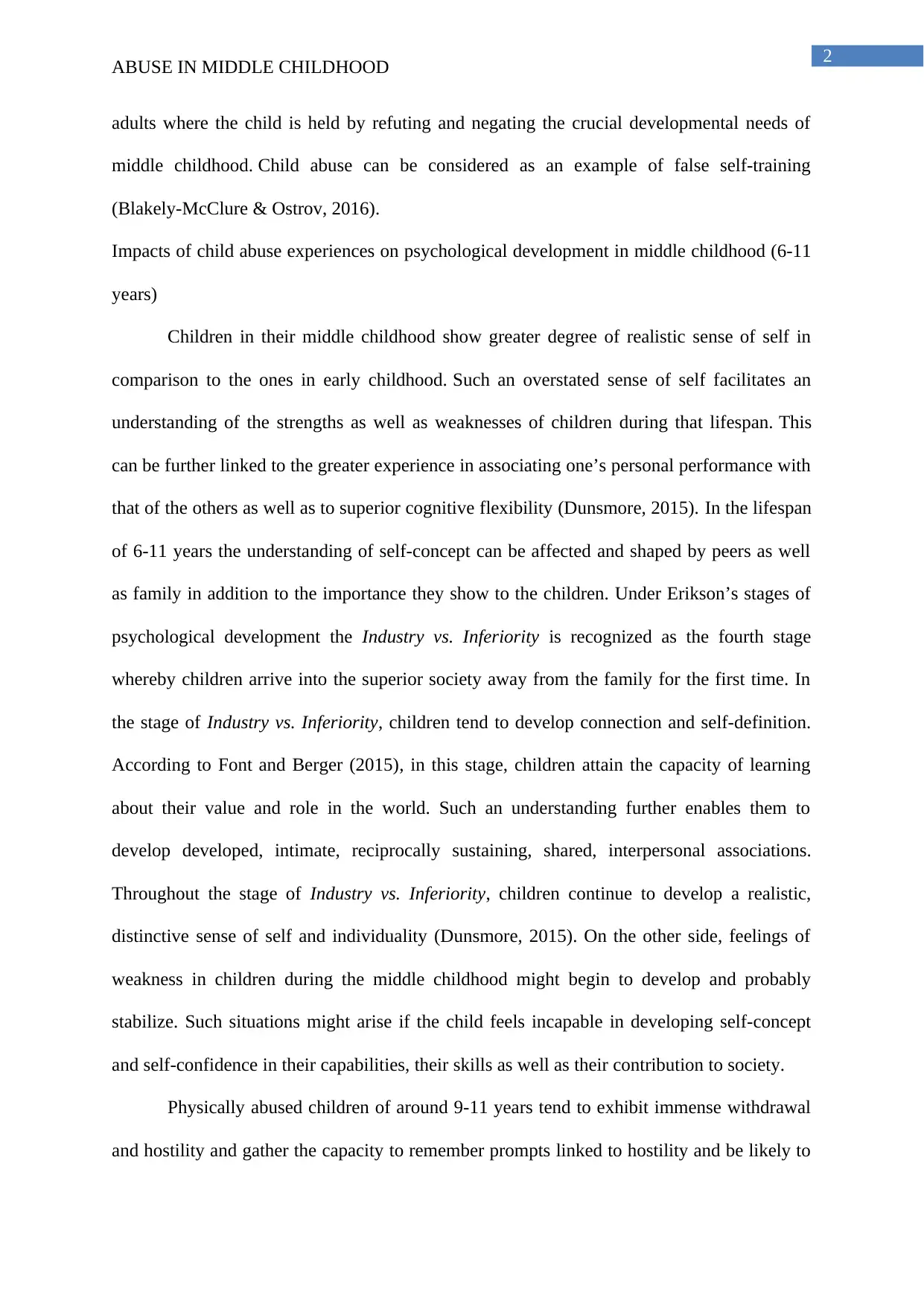
2
ABUSE IN MIDDLE CHILDHOOD
adults where the child is held by refuting and negating the crucial developmental needs of
middle childhood. Child abuse can be considered as an example of false self-training
(Blakely-McClure & Ostrov, 2016).
Impacts of child abuse experiences on psychological development in middle childhood (6-11
years)
Children in their middle childhood show greater degree of realistic sense of self in
comparison to the ones in early childhood. Such an overstated sense of self facilitates an
understanding of the strengths as well as weaknesses of children during that lifespan. This
can be further linked to the greater experience in associating one’s personal performance with
that of the others as well as to superior cognitive flexibility (Dunsmore, 2015). In the lifespan
of 6-11 years the understanding of self-concept can be affected and shaped by peers as well
as family in addition to the importance they show to the children. Under Erikson’s stages of
psychological development the Industry vs. Inferiority is recognized as the fourth stage
whereby children arrive into the superior society away from the family for the first time. In
the stage of Industry vs. Inferiority, children tend to develop connection and self-definition.
According to Font and Berger (2015), in this stage, children attain the capacity of learning
about their value and role in the world. Such an understanding further enables them to
develop developed, intimate, reciprocally sustaining, shared, interpersonal associations.
Throughout the stage of Industry vs. Inferiority, children continue to develop a realistic,
distinctive sense of self and individuality (Dunsmore, 2015). On the other side, feelings of
weakness in children during the middle childhood might begin to develop and probably
stabilize. Such situations might arise if the child feels incapable in developing self-concept
and self-confidence in their capabilities, their skills as well as their contribution to society.
Physically abused children of around 9-11 years tend to exhibit immense withdrawal
and hostility and gather the capacity to remember prompts linked to hostility and be likely to
ABUSE IN MIDDLE CHILDHOOD
adults where the child is held by refuting and negating the crucial developmental needs of
middle childhood. Child abuse can be considered as an example of false self-training
(Blakely-McClure & Ostrov, 2016).
Impacts of child abuse experiences on psychological development in middle childhood (6-11
years)
Children in their middle childhood show greater degree of realistic sense of self in
comparison to the ones in early childhood. Such an overstated sense of self facilitates an
understanding of the strengths as well as weaknesses of children during that lifespan. This
can be further linked to the greater experience in associating one’s personal performance with
that of the others as well as to superior cognitive flexibility (Dunsmore, 2015). In the lifespan
of 6-11 years the understanding of self-concept can be affected and shaped by peers as well
as family in addition to the importance they show to the children. Under Erikson’s stages of
psychological development the Industry vs. Inferiority is recognized as the fourth stage
whereby children arrive into the superior society away from the family for the first time. In
the stage of Industry vs. Inferiority, children tend to develop connection and self-definition.
According to Font and Berger (2015), in this stage, children attain the capacity of learning
about their value and role in the world. Such an understanding further enables them to
develop developed, intimate, reciprocally sustaining, shared, interpersonal associations.
Throughout the stage of Industry vs. Inferiority, children continue to develop a realistic,
distinctive sense of self and individuality (Dunsmore, 2015). On the other side, feelings of
weakness in children during the middle childhood might begin to develop and probably
stabilize. Such situations might arise if the child feels incapable in developing self-concept
and self-confidence in their capabilities, their skills as well as their contribution to society.
Physically abused children of around 9-11 years tend to exhibit immense withdrawal
and hostility and gather the capacity to remember prompts linked to hostility and be likely to
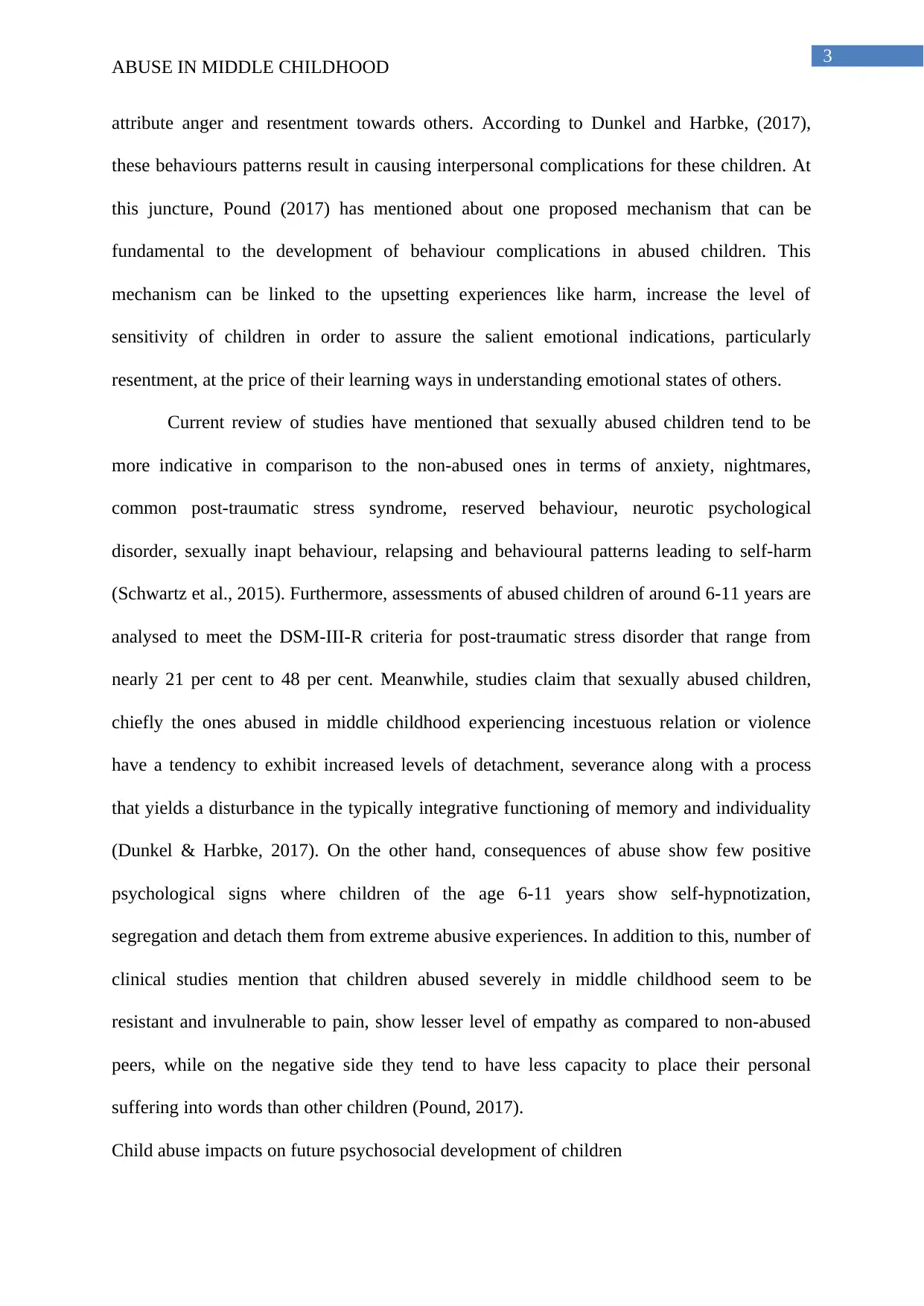
3
ABUSE IN MIDDLE CHILDHOOD
attribute anger and resentment towards others. According to Dunkel and Harbke, (2017),
these behaviours patterns result in causing interpersonal complications for these children. At
this juncture, Pound (2017) has mentioned about one proposed mechanism that can be
fundamental to the development of behaviour complications in abused children. This
mechanism can be linked to the upsetting experiences like harm, increase the level of
sensitivity of children in order to assure the salient emotional indications, particularly
resentment, at the price of their learning ways in understanding emotional states of others.
Current review of studies have mentioned that sexually abused children tend to be
more indicative in comparison to the non-abused ones in terms of anxiety, nightmares,
common post-traumatic stress syndrome, reserved behaviour, neurotic psychological
disorder, sexually inapt behaviour, relapsing and behavioural patterns leading to self-harm
(Schwartz et al., 2015). Furthermore, assessments of abused children of around 6-11 years are
analysed to meet the DSM-III-R criteria for post-traumatic stress disorder that range from
nearly 21 per cent to 48 per cent. Meanwhile, studies claim that sexually abused children,
chiefly the ones abused in middle childhood experiencing incestuous relation or violence
have a tendency to exhibit increased levels of detachment, severance along with a process
that yields a disturbance in the typically integrative functioning of memory and individuality
(Dunkel & Harbke, 2017). On the other hand, consequences of abuse show few positive
psychological signs where children of the age 6-11 years show self-hypnotization,
segregation and detach them from extreme abusive experiences. In addition to this, number of
clinical studies mention that children abused severely in middle childhood seem to be
resistant and invulnerable to pain, show lesser level of empathy as compared to non-abused
peers, while on the negative side they tend to have less capacity to place their personal
suffering into words than other children (Pound, 2017).
Child abuse impacts on future psychosocial development of children
ABUSE IN MIDDLE CHILDHOOD
attribute anger and resentment towards others. According to Dunkel and Harbke, (2017),
these behaviours patterns result in causing interpersonal complications for these children. At
this juncture, Pound (2017) has mentioned about one proposed mechanism that can be
fundamental to the development of behaviour complications in abused children. This
mechanism can be linked to the upsetting experiences like harm, increase the level of
sensitivity of children in order to assure the salient emotional indications, particularly
resentment, at the price of their learning ways in understanding emotional states of others.
Current review of studies have mentioned that sexually abused children tend to be
more indicative in comparison to the non-abused ones in terms of anxiety, nightmares,
common post-traumatic stress syndrome, reserved behaviour, neurotic psychological
disorder, sexually inapt behaviour, relapsing and behavioural patterns leading to self-harm
(Schwartz et al., 2015). Furthermore, assessments of abused children of around 6-11 years are
analysed to meet the DSM-III-R criteria for post-traumatic stress disorder that range from
nearly 21 per cent to 48 per cent. Meanwhile, studies claim that sexually abused children,
chiefly the ones abused in middle childhood experiencing incestuous relation or violence
have a tendency to exhibit increased levels of detachment, severance along with a process
that yields a disturbance in the typically integrative functioning of memory and individuality
(Dunkel & Harbke, 2017). On the other hand, consequences of abuse show few positive
psychological signs where children of the age 6-11 years show self-hypnotization,
segregation and detach them from extreme abusive experiences. In addition to this, number of
clinical studies mention that children abused severely in middle childhood seem to be
resistant and invulnerable to pain, show lesser level of empathy as compared to non-abused
peers, while on the negative side they tend to have less capacity to place their personal
suffering into words than other children (Pound, 2017).
Child abuse impacts on future psychosocial development of children
Secure Best Marks with AI Grader
Need help grading? Try our AI Grader for instant feedback on your assignments.

4
ABUSE IN MIDDLE CHILDHOOD
The experiences of child abuse in middle childhood affect the developmental task and
consequently become a behavioural pattern. As children develop greater level of maturity, a
novel and inclusive contact to different people external to the home environment leads a child
to develop relationships, associations or contacts that expands their social realm (Lines et al.,
2017). Furthermore, it unlocks the prospect of retrieval from hostile childhood involvement
or a recurrence of a new form of mistreatment. According to Blakely-McClure and Ostrov
(2016), the prevention of a disturbing home atmosphere is greatly suggested instead of a
complete system of treatment and rehabilitation. Abuse during childhood is interrelated to
changes in the brain structure that possibly will cause depression in a more critical level in
future life. Comprehensive studies reveal that a region in the brain gets involved in emotional
awareness explained as the insular cortex that gets minor for the ones who experience
childhood abuse in middle childhood (Dunkel & Harbke, 2017). Furthermore, prolonged
contact to hostile encounters like physical or sexual abuse gives rise to sufferings in middle
childhood that subsequently changes the structure of the brain. These changes result in
reappearance of dejection and poorer outcomes. Anxiety disorder and personal as well as
interpersonal concern are usually experienced as a consequence of adverse childhood
experiences. In addition, disruptive experiences are linked to neurotic behaviours in future
development. According to studies, if the sexual abuse is extended towards a girl or a boy in
their middle childhood, the rate of traumatization experienced remains the same (Pound,
2017). These experiences are referred as damage of psychological space as well as the assault
of physical space with the severe practice of force over the victim. It is a long-term exercise
for victim to mature in the deficiency of suitable parental care. Thus, establishing and
properly maintaining limitations aid children to recover from abuse and re-establishes their
self-concept and image (Killam et al., 2017).
Role of Registered nurses in improving their psychological conditions
ABUSE IN MIDDLE CHILDHOOD
The experiences of child abuse in middle childhood affect the developmental task and
consequently become a behavioural pattern. As children develop greater level of maturity, a
novel and inclusive contact to different people external to the home environment leads a child
to develop relationships, associations or contacts that expands their social realm (Lines et al.,
2017). Furthermore, it unlocks the prospect of retrieval from hostile childhood involvement
or a recurrence of a new form of mistreatment. According to Blakely-McClure and Ostrov
(2016), the prevention of a disturbing home atmosphere is greatly suggested instead of a
complete system of treatment and rehabilitation. Abuse during childhood is interrelated to
changes in the brain structure that possibly will cause depression in a more critical level in
future life. Comprehensive studies reveal that a region in the brain gets involved in emotional
awareness explained as the insular cortex that gets minor for the ones who experience
childhood abuse in middle childhood (Dunkel & Harbke, 2017). Furthermore, prolonged
contact to hostile encounters like physical or sexual abuse gives rise to sufferings in middle
childhood that subsequently changes the structure of the brain. These changes result in
reappearance of dejection and poorer outcomes. Anxiety disorder and personal as well as
interpersonal concern are usually experienced as a consequence of adverse childhood
experiences. In addition, disruptive experiences are linked to neurotic behaviours in future
development. According to studies, if the sexual abuse is extended towards a girl or a boy in
their middle childhood, the rate of traumatization experienced remains the same (Pound,
2017). These experiences are referred as damage of psychological space as well as the assault
of physical space with the severe practice of force over the victim. It is a long-term exercise
for victim to mature in the deficiency of suitable parental care. Thus, establishing and
properly maintaining limitations aid children to recover from abuse and re-establishes their
self-concept and image (Killam et al., 2017).
Role of Registered nurses in improving their psychological conditions
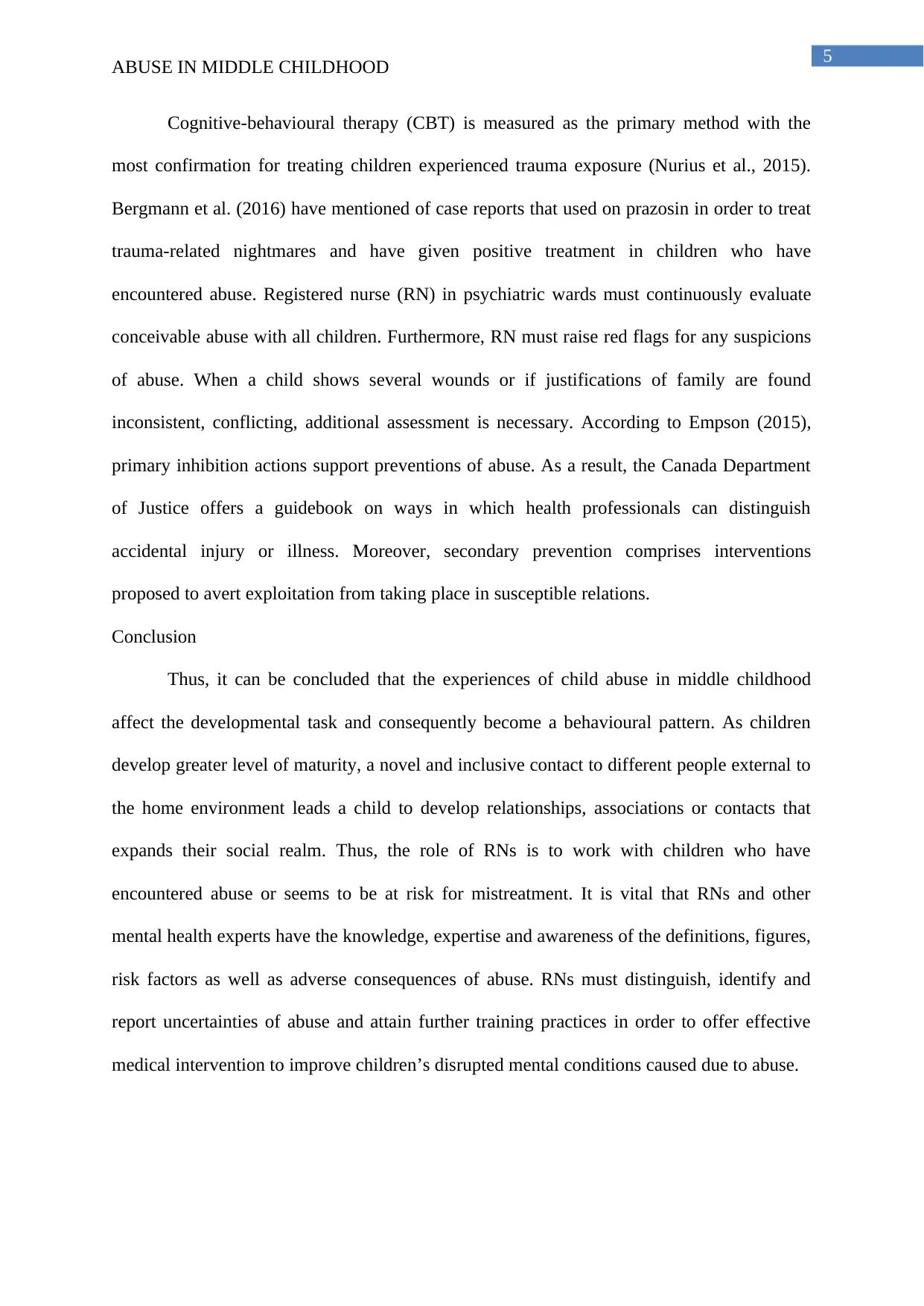
5
ABUSE IN MIDDLE CHILDHOOD
Cognitive-behavioural therapy (CBT) is measured as the primary method with the
most confirmation for treating children experienced trauma exposure (Nurius et al., 2015).
Bergmann et al. (2016) have mentioned of case reports that used on prazosin in order to treat
trauma-related nightmares and have given positive treatment in children who have
encountered abuse. Registered nurse (RN) in psychiatric wards must continuously evaluate
conceivable abuse with all children. Furthermore, RN must raise red flags for any suspicions
of abuse. When a child shows several wounds or if justifications of family are found
inconsistent, conflicting, additional assessment is necessary. According to Empson (2015),
primary inhibition actions support preventions of abuse. As a result, the Canada Department
of Justice offers a guidebook on ways in which health professionals can distinguish
accidental injury or illness. Moreover, secondary prevention comprises interventions
proposed to avert exploitation from taking place in susceptible relations.
Conclusion
Thus, it can be concluded that the experiences of child abuse in middle childhood
affect the developmental task and consequently become a behavioural pattern. As children
develop greater level of maturity, a novel and inclusive contact to different people external to
the home environment leads a child to develop relationships, associations or contacts that
expands their social realm. Thus, the role of RNs is to work with children who have
encountered abuse or seems to be at risk for mistreatment. It is vital that RNs and other
mental health experts have the knowledge, expertise and awareness of the definitions, figures,
risk factors as well as adverse consequences of abuse. RNs must distinguish, identify and
report uncertainties of abuse and attain further training practices in order to offer effective
medical intervention to improve children’s disrupted mental conditions caused due to abuse.
ABUSE IN MIDDLE CHILDHOOD
Cognitive-behavioural therapy (CBT) is measured as the primary method with the
most confirmation for treating children experienced trauma exposure (Nurius et al., 2015).
Bergmann et al. (2016) have mentioned of case reports that used on prazosin in order to treat
trauma-related nightmares and have given positive treatment in children who have
encountered abuse. Registered nurse (RN) in psychiatric wards must continuously evaluate
conceivable abuse with all children. Furthermore, RN must raise red flags for any suspicions
of abuse. When a child shows several wounds or if justifications of family are found
inconsistent, conflicting, additional assessment is necessary. According to Empson (2015),
primary inhibition actions support preventions of abuse. As a result, the Canada Department
of Justice offers a guidebook on ways in which health professionals can distinguish
accidental injury or illness. Moreover, secondary prevention comprises interventions
proposed to avert exploitation from taking place in susceptible relations.
Conclusion
Thus, it can be concluded that the experiences of child abuse in middle childhood
affect the developmental task and consequently become a behavioural pattern. As children
develop greater level of maturity, a novel and inclusive contact to different people external to
the home environment leads a child to develop relationships, associations or contacts that
expands their social realm. Thus, the role of RNs is to work with children who have
encountered abuse or seems to be at risk for mistreatment. It is vital that RNs and other
mental health experts have the knowledge, expertise and awareness of the definitions, figures,
risk factors as well as adverse consequences of abuse. RNs must distinguish, identify and
report uncertainties of abuse and attain further training practices in order to offer effective
medical intervention to improve children’s disrupted mental conditions caused due to abuse.
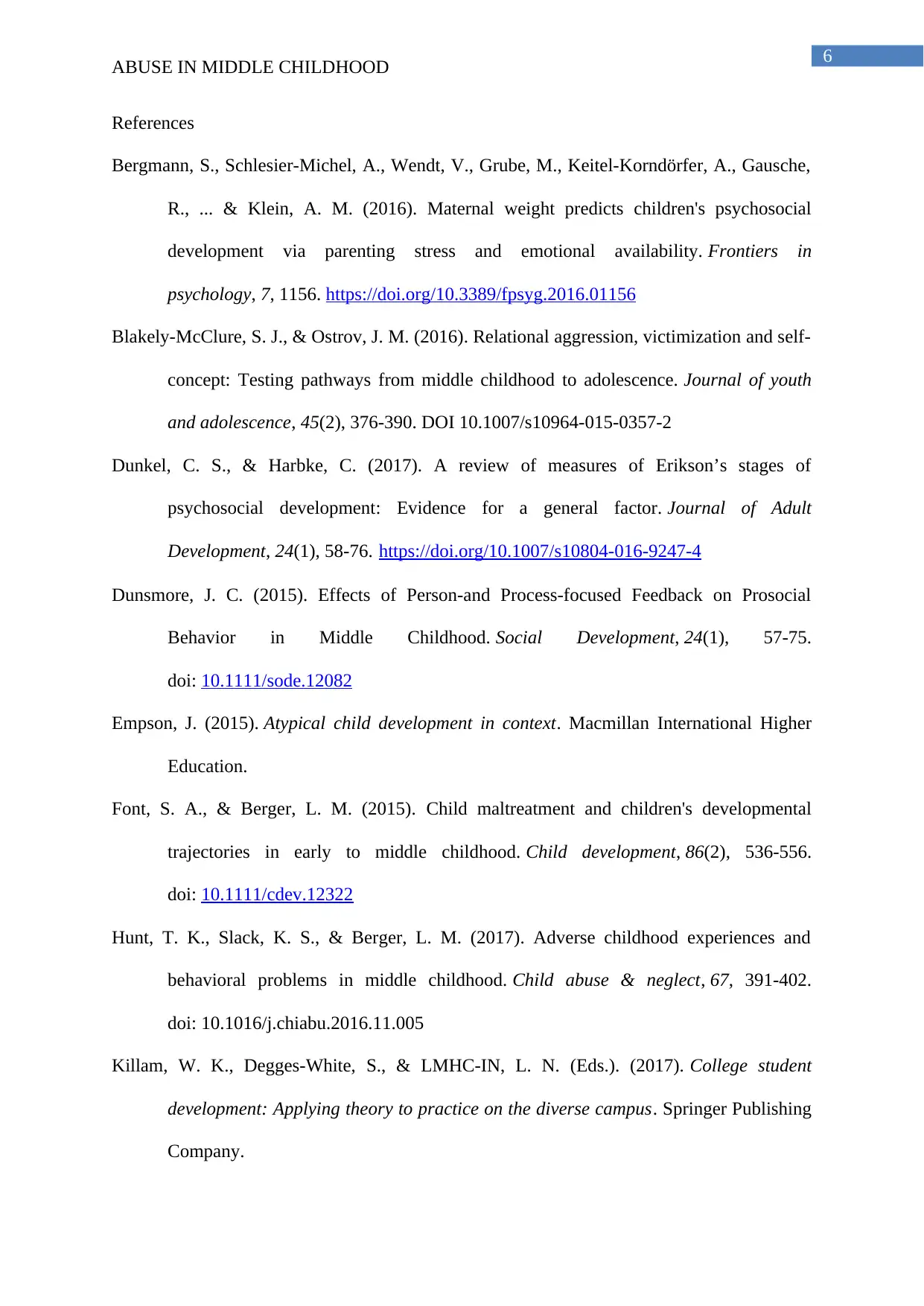
6
ABUSE IN MIDDLE CHILDHOOD
References
Bergmann, S., Schlesier-Michel, A., Wendt, V., Grube, M., Keitel-Korndörfer, A., Gausche,
R., ... & Klein, A. M. (2016). Maternal weight predicts children's psychosocial
development via parenting stress and emotional availability. Frontiers in
psychology, 7, 1156. https://doi.org/10.3389/fpsyg.2016.01156
Blakely-McClure, S. J., & Ostrov, J. M. (2016). Relational aggression, victimization and self-
concept: Testing pathways from middle childhood to adolescence. Journal of youth
and adolescence, 45(2), 376-390. DOI 10.1007/s10964-015-0357-2
Dunkel, C. S., & Harbke, C. (2017). A review of measures of Erikson’s stages of
psychosocial development: Evidence for a general factor. Journal of Adult
Development, 24(1), 58-76. https://doi.org/10.1007/s10804-016-9247-4
Dunsmore, J. C. (2015). Effects of Person‐and Process‐focused Feedback on Prosocial
Behavior in Middle Childhood. Social Development, 24(1), 57-75.
doi: 10.1111/sode.12082
Empson, J. (2015). Atypical child development in context. Macmillan International Higher
Education.
Font, S. A., & Berger, L. M. (2015). Child maltreatment and children's developmental
trajectories in early to middle childhood. Child development, 86(2), 536-556.
doi: 10.1111/cdev.12322
Hunt, T. K., Slack, K. S., & Berger, L. M. (2017). Adverse childhood experiences and
behavioral problems in middle childhood. Child abuse & neglect, 67, 391-402.
doi: 10.1016/j.chiabu.2016.11.005
Killam, W. K., Degges-White, S., & LMHC-IN, L. N. (Eds.). (2017). College student
development: Applying theory to practice on the diverse campus. Springer Publishing
Company.
ABUSE IN MIDDLE CHILDHOOD
References
Bergmann, S., Schlesier-Michel, A., Wendt, V., Grube, M., Keitel-Korndörfer, A., Gausche,
R., ... & Klein, A. M. (2016). Maternal weight predicts children's psychosocial
development via parenting stress and emotional availability. Frontiers in
psychology, 7, 1156. https://doi.org/10.3389/fpsyg.2016.01156
Blakely-McClure, S. J., & Ostrov, J. M. (2016). Relational aggression, victimization and self-
concept: Testing pathways from middle childhood to adolescence. Journal of youth
and adolescence, 45(2), 376-390. DOI 10.1007/s10964-015-0357-2
Dunkel, C. S., & Harbke, C. (2017). A review of measures of Erikson’s stages of
psychosocial development: Evidence for a general factor. Journal of Adult
Development, 24(1), 58-76. https://doi.org/10.1007/s10804-016-9247-4
Dunsmore, J. C. (2015). Effects of Person‐and Process‐focused Feedback on Prosocial
Behavior in Middle Childhood. Social Development, 24(1), 57-75.
doi: 10.1111/sode.12082
Empson, J. (2015). Atypical child development in context. Macmillan International Higher
Education.
Font, S. A., & Berger, L. M. (2015). Child maltreatment and children's developmental
trajectories in early to middle childhood. Child development, 86(2), 536-556.
doi: 10.1111/cdev.12322
Hunt, T. K., Slack, K. S., & Berger, L. M. (2017). Adverse childhood experiences and
behavioral problems in middle childhood. Child abuse & neglect, 67, 391-402.
doi: 10.1016/j.chiabu.2016.11.005
Killam, W. K., Degges-White, S., & LMHC-IN, L. N. (Eds.). (2017). College student
development: Applying theory to practice on the diverse campus. Springer Publishing
Company.
Paraphrase This Document
Need a fresh take? Get an instant paraphrase of this document with our AI Paraphraser
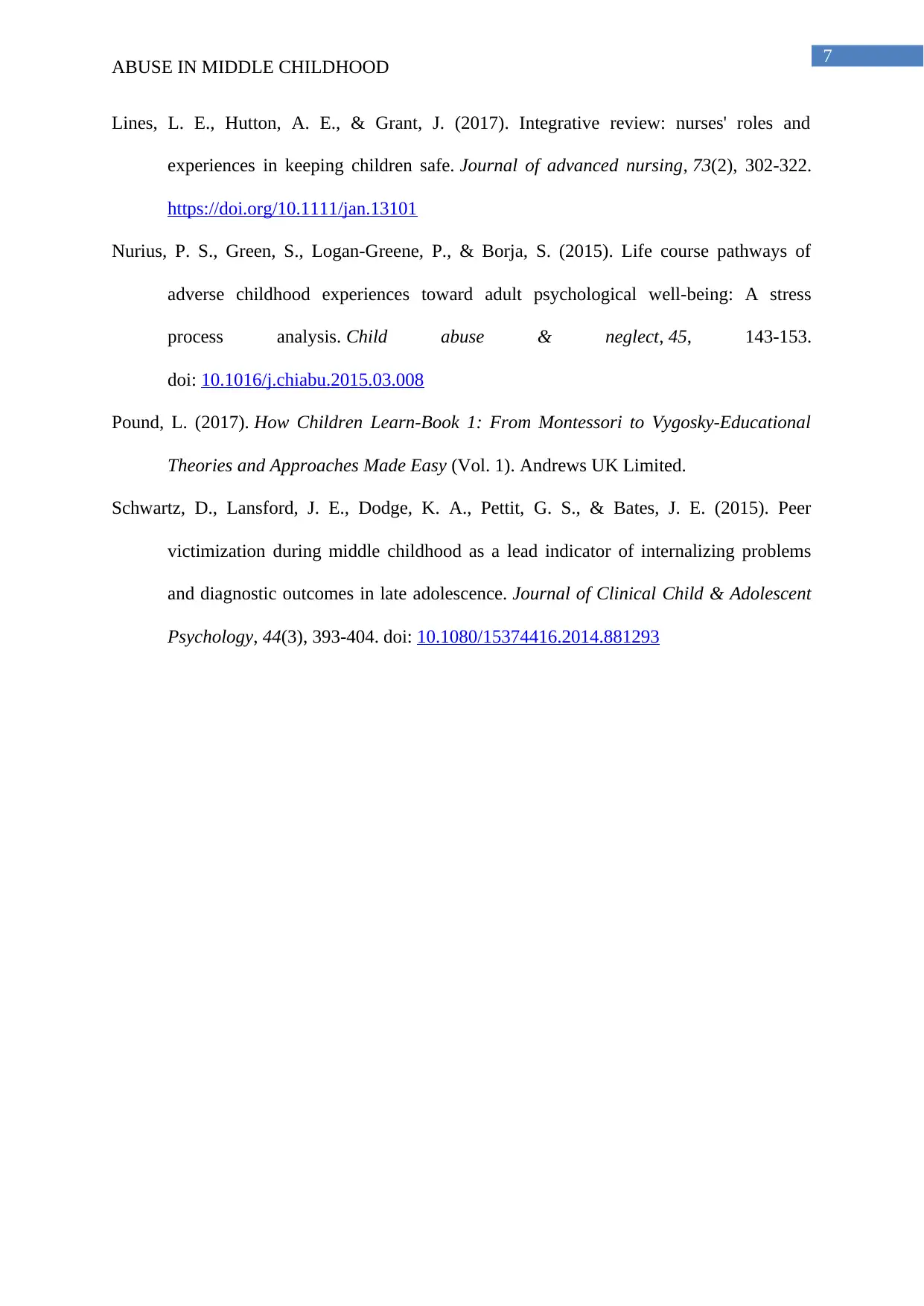
7
ABUSE IN MIDDLE CHILDHOOD
Lines, L. E., Hutton, A. E., & Grant, J. (2017). Integrative review: nurses' roles and
experiences in keeping children safe. Journal of advanced nursing, 73(2), 302-322.
https://doi.org/10.1111/jan.13101
Nurius, P. S., Green, S., Logan-Greene, P., & Borja, S. (2015). Life course pathways of
adverse childhood experiences toward adult psychological well-being: A stress
process analysis. Child abuse & neglect, 45, 143-153.
doi: 10.1016/j.chiabu.2015.03.008
Pound, L. (2017). How Children Learn-Book 1: From Montessori to Vygosky-Educational
Theories and Approaches Made Easy (Vol. 1). Andrews UK Limited.
Schwartz, D., Lansford, J. E., Dodge, K. A., Pettit, G. S., & Bates, J. E. (2015). Peer
victimization during middle childhood as a lead indicator of internalizing problems
and diagnostic outcomes in late adolescence. Journal of Clinical Child & Adolescent
Psychology, 44(3), 393-404. doi: 10.1080/15374416.2014.881293
ABUSE IN MIDDLE CHILDHOOD
Lines, L. E., Hutton, A. E., & Grant, J. (2017). Integrative review: nurses' roles and
experiences in keeping children safe. Journal of advanced nursing, 73(2), 302-322.
https://doi.org/10.1111/jan.13101
Nurius, P. S., Green, S., Logan-Greene, P., & Borja, S. (2015). Life course pathways of
adverse childhood experiences toward adult psychological well-being: A stress
process analysis. Child abuse & neglect, 45, 143-153.
doi: 10.1016/j.chiabu.2015.03.008
Pound, L. (2017). How Children Learn-Book 1: From Montessori to Vygosky-Educational
Theories and Approaches Made Easy (Vol. 1). Andrews UK Limited.
Schwartz, D., Lansford, J. E., Dodge, K. A., Pettit, G. S., & Bates, J. E. (2015). Peer
victimization during middle childhood as a lead indicator of internalizing problems
and diagnostic outcomes in late adolescence. Journal of Clinical Child & Adolescent
Psychology, 44(3), 393-404. doi: 10.1080/15374416.2014.881293
1 out of 8
Related Documents
Your All-in-One AI-Powered Toolkit for Academic Success.
+13062052269
info@desklib.com
Available 24*7 on WhatsApp / Email
![[object Object]](/_next/static/media/star-bottom.7253800d.svg)
Unlock your academic potential
© 2024 | Zucol Services PVT LTD | All rights reserved.





